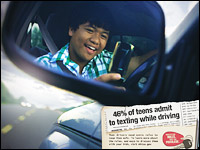
There is good news and bad news for driver safety in the U.S.: The good news is that highway deaths fell to 32,885 in 2010, the lowest level since 1949, according to the Department of Transportation’s National Highway Traffic Safety Administration’s updated fatality and injury data. This decline came even as drivers traveled nearly 46 billion more miles during the year, for an increase of 1.6 percent over the 2009 level.
The bad news, however, is delivered in the same report. The NHTSA unveiled a new measure of fatalities related to distracted driving, which it calls “distraction-affected crashes.” There were an estimated 3,092 fatalities in this category last year — despite the plethora of local laws passed to ban such behavior, and despite the numerous public safety and education campaigns to discourage it.
The new measure, part of the agency’s efforts to refine its data collection, focuses specifically on crashes that were caused because the driver had likely been distracted by dialing a cellphone, texting, or being otherwise distracted by a person or event.
NHTSA will continue to refine it study of distracted driving. It is planning a study in which 2,000 cars will be fitted with cameras and other equipment to record driver behavior over a period of two years. The expectation is that researchers can use the data to identify which behavior is most likely to lead to a crash. The study results are expected to be available in 2014.
The agency declined to provide further details.
Law and Order
Opinions about how to reduce the incidence of deaths due to driver distraction range from better enforcing the existing laws to mounting more elaborate public safety and education campaigns. There are advocates for both points of view.
“First we have to get every state to have a law on the books banning texting and talking while driving,” Jonathan Adkins, a spokesperson for the Governors Highway Safety Association, told TechNewsWorld. Most states moved rapidly to pass such laws in the last few years, but there are about 15 that haven’t.
Along with pursuing that goal, it is essential that states implement stronger enforcement measures, Adkins continued.
“These laws need to be aggressively enforced — and publicly enforced as well,” he stressed. “People need to know that if they are seen texting or talking on the phone while driving, they will be pulled over, and they will be given a ticket.”
This is how the nation was able to increase the use of seatbelts and slow down incidents of drunk driving, he said. “We want to apply those same lessons to texting and talking now.”
The penalties for such behavior — tickets ranging from US$50 to $200 — are not as severe as for driving under the influence, Adkins acknowledged. “But this is not so much about the fine than about making it clear people are breaking the law. Besides, no one likes to be pulled over.”
Multipronged Approach
There are other ways to get incidents of distracted driving to drop, Adkins continued. “Technology can help. It has created the problem, yes, but it also has the potential of being a solution.”
There are apps, for example, that detect when a device is in motion and then shut off communication.
Also important are company policies that forbid the use of mobile devices while operating a vehicle on company time, he said. “For certain professions, such as in the media where everything is time-sensitive, this can be essential.”
Employers can be held liable if an employee caused a crash while conducting business on the phone, noted Adkins — especially if there is no such policy in place.
Finally, more education campaigns are needed, he said. “Despite the fact that there is so much awareness of this problem, it is just getting worse.”
A Learning Experience
The National Youth Leadership Council has undertaken an educational initiative, Project Ignition, that aims to teach teenagers responsible driving practices.
Project Ignition has made a significant impact among the youth involved in it, spokesperson Mike VanKeulen told TechNewsWorld.
“Service learning is the primary methodology to Project Ignition, ” he remarked.
For example, in a physics class, students might learn the dynamics of a car crash — especially a in a slow-moving car, when someone is more likely to be texting and distracted. In a language arts class, students might design engagement strategies to get the message out about the dangers of texting and talking while driving, VanKeulen said.
“What these schools are doing is encouraging students to take ownership of the issue,” he concluded.





















































what’s next? the radio, the disc player, the cigarets, the air conditioner? the heater? the window buttons> come on people!! they each have a "knob" or two. and it could cause a ‘swerve’ to the left or right. we just have to watch the ‘other’ drivers and be aware of what "they" are doing in their cars as we drive. which was part of our "training". REMEMBER?? I AM sick of these Turkeys trying to take away our freedoms a little at a time.